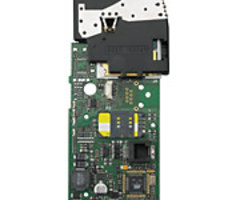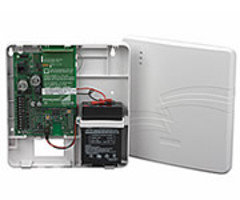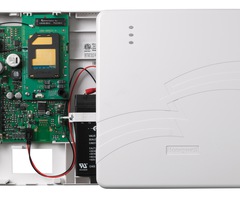Honeywell GSMV, GSMV4G, GSMVCN, IGSMV, and IGSMVCN GSM Quick Install Guide
Related Products




Related Categories
Document Transcript
GSMV / GSMVCN, and IGSMV / IGSMVCN GSM Communication Module – Quick Installation Guide
For Online Support visit: http://www.security.honeywell.com/hsc/resources/MyWebTech/
General Information
Congratulations on your purchase of Honeywell's GSMV or IGSMV communication module. The GSMV and IGSMV send alarms and messages from the security system’s control panel to AlarmNet for subsequent transfer to the central monitoring station. In addition to alarm reporting, the GSMV and IGSMV provide two-way voice communications with the central station (when used with Honeywell’s AVS Audio Verification System) and provides upload/downloading capability of Honeywell's control panel data. NOTE: Two-way voice is not compatible with Honeywell Commercial Control Panels (such as the VISTA-128/250 series).
Component Identification
STATUS LED MESSAGE LED FAULT LED
7720P PROGRAMMER PORT TB 1 1 2 3 4 5 6 7 8 9 10 11 1
PRIMARY POWER: 9 - 16.5 VAC CURRENT: BATTERY: 8V. 3.1 AHr FOR 24 Hr BACKUP
FCC:XXXXXXXXXX
IC: YYYYYYYYYY
UL / ULC
Two-way voice has not been evaluated by UL/ULC.
The IGSMV communications module has all of the features of the GSMV and adds internet connectivity. (For Canada, the GSMVCN and the IGSMVCN are designed to comply with Canadian GSM connectivity specifications.) The GSMV and IGSMV represent the latest and most innovative communication technology for the security industry and uses the most sophisticated encryption to ensure the highest level of security for your customer. Since this guide covers both models, where differences occur they will be noted. This guide addresses a simple installation using default programming values where possible and is applicable for the majority of installations. For detailed information, and configuration of remote services, please refer to the appropriate Installation and Setup Guide for the product. The GSMV and the IGSMV are henceforth referred to as the communications module or module. ! The communications module requires an AlarmNet account. For new installations, please obtain the account information from the central station prior to programming this module. ! The communications module is for control panels that support GSM or IGSM communicators and the ECP communications bus. For control panels that do not support ECP, refer to the appropriate installation guide to use other modes. ! The control panel treats the communications module as an ECP device, so program the control panel accordingly. Refer to the control panel’s Installation and Setup Guide for details. REMOTE SERVICES Honeywell offers secure web based services that enable users to remotely monitor and control their security system. These web services enable users to: monitor and control their security system from a website, receive email and text message notifications of system events, and use text messages to control the system and receive confirmations. Dealers can enroll their customers for "Remote Services" by using the AlarmNet Direct website. Once enabled, the specific programming fields associated with these features can be programmed into the communications device either remotely using the AlarmNet Direct website or locally using the 7720P programming tool.
AC 1 AC 2 ECP(+) VOLTAGE INPUT GND ECP INPUT ECP OUTPUT
BLACK
RED
RSSI / MODE AND STATUS LEDs MOUNTING HOLE (UNDER BATTERY)
GPRS
RSSI
IBS
M1 M0
FAULT OUTPUT MOUNTING HOLE
BATTERY
BLK RED
TAMPER SWITCH
J1 BATTERY CONNECTOR
RJ45 NETWORK ETHERNET CONNECTIVITY PORT LED DISPLAY (SUPERVISED) IGSMV / IGSMVCN Only
MODE AND STATUS INDICATOR SWITCH
POWER LOADING SPECIFICATIONS GSMV / GSMVCN: 35mA average standby, 500mA peak transmit. IGSMV / IGSMVCN: 65mA average standby, 500mA peak transmit.
1. Determine Signal Strength and Select a Location
The communications module must be mounted indoors. When choosing a suitable mounting location, understand that signal strength is very important for proper operation. For most installations using the internal antenna, mounting the unit as high as practical, and avoiding large metal components provides adequate signal strength for proper operation. In this step, you will use the communications module to determine signal strength in order to find a suitable mounting location. Note: If the SIM is already activated, the RSSI signal strength indicators will indicate signal strength. (The SIM in the GSMVCN and IGSMVCN is already activated.) If the SIM has not been activated, the firmware in the communications module enables it to communicate with the cellular network towers (without the SIM being activated) so that signal strength measurements can be determined. In this case, you can display the signal strength by simultaneously pressing the MODE and TAMPER switches. RF Exposure Warning – The antenna(s) used for this transmitter must be installed to provide a separation distance of at least 20cm from all persons and must not be collocated or operating in conjunction with any other antenna or transmitter. 1. Unpack the module and detach the case back by pushing up into the two tabs located at the bottom of the IGSMV with the blade of a screwdriver while pulling the case back and case front apart. 2. Temporarily connect the module to the AC transformer, supplied. 3. Choose the installation site with the best signal strength by observing the signal strength (RSSI) bar graph. Signal 3 BARS MIN. strength should be within 3-5 bars. The best signal R Y Y G G G strength is usually found at the highest point in the building, near a window. Unplug the transformer. 4. Mark the location for the communications module.
7845i-GSM-025-V0
2. Mount and Wire the Module
1. Locate the case back over selected mounting position such that the opening in the case back is aligned with the wire/cable opening on the mounting surface. 2. Pass the wires/cable through the opening in the case back, or route through the removable knockouts located on the back cover. Then secure the case back to the mounting surface using four screws (supplied). 3. Make the following connections:
TRANSFORMER TB1 1 2 +12V AUX GND DATA OUT DATA IN RED BLK YEL GRN 3 4 5 6 AC INPUT 1 AC INPUT 2 ECP (+) VOLTAGE INPUT GND
RX TX
CASE BACK
MOUNTING SCREW (4) (TYP)
MOUNTING SURFACE
OPTIONAL WIRING KNOCKOUT
ECP DATA IN ECP DATA OUT
J1
GSM GPPS WEB MODE 2 MODE 1 RSSI
BATTERY
VISTA CONTROL PANEL
COMMUNICATIONS MODULE
iGSMBR-005-V0
4. When all wiring has been completed (including the Internet cable and Audio cable if used), attach the case front. Position the top first, then press the bottom section until it snaps in place. Secure bottom using the supplied cover screw. (Required for UL installations.) 5. You may power up the module and control panel.
Distance from Control Panel 75 ft (23m) 120 ft (37m) Minimum Wire Gauge #22 #20 Distance from Control Panel 170 ft (52m) 270 ft (82m) Minimum Wire Gauge #18 #16
TAB OPTIONAL WIRING KNOCKOUTS TAB
COVER SECURING SCREW
3. Connect the Internet Cable (IGSMV / IGSMVCN only)
Connect one end of the Ethernet cable (Category 5) to the module’s RJ45 Ethernet connector and the other end to the cable/DSL router as shown in the figure below. ! For UL installations, the Ethernet connection between the communications module and the router cannot exceed 12 feet. Both units must be located within the same room. ! Use a Listed cable/DSL router suited for the application.
7720P PROGRAM CONNECTOR
UL
IBS GPRS
J1 BATTERY CONNECTOR
TO ROUTER
iGSMBR-012-V0
M1 M0 RSSI
RJ45 (FOR INTERNET CONNECTION)
4. Connect and Route the Audio Cable for Two-way Voice (if used)
The communications module requires an audio cable (supplied with the GSMV) to support twoway voice using an AVS Base Unit. Note the AVS Base Unit is part of Honeywell’s AVS Audio Verification System. This system consist of the AVS Base Unit, Remote Station, and the Remote Station PC board. For detailed information, please refer to the AVS Audio Verification System documentation. Follow the guidelines below for connecting the audio cable. 1. Power down the control panel and AVS Audio Verification System. (When the module is fully wired up, restore power to the control panel and AVS Audio Verification System.) 2. At the module, remove two [2] screws and standoff that secure the small PC board, and swing up. 3. Connect one end of the audio cable to the audio connector located on the small PC board. 4. Secure the small PC board and plastic standoff with two [2] screws. Note the standoff mounts on the right side. 5. Route the audio cable to the connector on the AVS Base Unit and connect the cable. 6. Ensure the audio cable ends are secured with tie wraps to reduce strain.
TB 1 1 2 3 4 5 6 7 8 9 10 11
FOR EXTERNAL ANTENNA 50 OHM, MMCX ONLY
7720P PROGRAMMER PORT NOT FOR TELEPHONE SERVICE USE! TRANSMIT LED PRIMARY POWER: BATTERY: 6V. 3.1 AHr FOR 24 Hr BACKUP FCC ID: GIPMC56 IC: Y267W - MC56
MAC LABEL HERE
RX GSM GPPS WEB MODE 2 MODE 1 RSSI TX
Honeywell
AVS BASE UNIT
ON
ON
1
2
3
4
1
2
3
4
5
RX TX GSM S GPP WEB E 2 MOD E 1 MOD I RSS
RX
5. Setup the Account, Activate the SIM, Program, and Register the Module
SETUP THE ACCOUNT To setup the customer account you will need to contact the central monitoring station to get account information, and have access to the AlarmNet Direct website. To access the AlarmNet Direct website visit – https://services.alarmnet.com/AlarmNetDirect If you do not wish to use the AlarmNet Direct website, you may call AlarmNet to setup the account; just phone 800-222-6525, then select option 1. (Monday–Friday 8:00 am to 9:00 pm, Saturday 9:00 am to 5:30 pm EST) Have the following information ready: Using the 7720 Programming Tool: Ensure the system is powered up and connect the programming tool to the module. Accept all default settings except the following prompts which need to be answered. Then exit the programming mode. Device Mode ECP Primary City ID (??) Primary CS ID (??) Primary Sub ID (????) Device Address (03) Press [#]. Enter number 01-99, then press [#]. Enter number 01-FE, then press [#]. Enter number 0001-9999, then press [#]. Accept the default by pressing [#], or change if this address is already used.
! Primary City ID (two digits),
obtained from your monitoring station.
! Primary Subscriber ID (four digits), obtained from
your monitoring station.
! Primary Central Station ID (two
digits), obtained from your monitoring station. ACTIVATE THE SIM
! Communication Module's MAC ID, and MAC CRC
number located on outside of box, and inside of the module.
AUDCBL-002-V0
Note: The communications module comes with a SIM (Subscriber Identity Module) that needs to be activated. The GSMVCN and IGSMVCN come already activated. 1. To activate the SIM, log into the AlarmNet Direct website and choose “SIM Activation/Status”, then enter the required information. Click Activate SIM. 2. Setup the customer account by choosing "Program New Device GSM/I", enter the required information. When complete, click DONE. You may log out of the AlarmNet Direct website. PROGRAM THE MODULE Using the AlarmNet Direct website: Log in as you did to activate the SIM and complete the programming. Refer to the online help if necessary.
GRN
YEL
RED
Ê800-07994#Š
800-07994 11/10 Rev. A
TX GSM GPPS WEB MODE 2 MODE 1 RSSI
The following prompt appears for the IGSMV and IGSMVCN only. Notify Panel of Neither Fault Press [!] to scroll, choose Notify Panel of Both IP&GSM Flts, then press [#].
REGISTER THE MODULE Registering the module activates the account with AlarmNet and enables the control panel to send reports. There are three ways to register the communications module. ! You can register the module by logging into AlarmNet Direct choosing “Show Programmed Devices GSM/I”. Search for the account using the Account Information or MAC ID. Under the “Actions” column, use the pulldown menu select Register the account. ! After the module is installed and programmed, you can register the module by clicking the Tamper Switch 3 times. ! After the module is installed and programmed, you can register the module using the 7720P Programming tool. Simply: Press [Shift ] then press [!]. Please wait for "Registration SUCCESS" message.
Note: If all LEDs FAST BLINK in unison with the RSSI LEDs this indicates a Hardware Error. ON – NOT registered with AlarmNet. OFF – Registered with AlarmNet. FAST BLINK – Download session with Compass in progress. SLOW BLINK – In unison with yellow LED, registration in progress. ON – Message transmission pending. QUICK PERIODIC BLINK – Normal. FAST BLINK – Message waiting for network ACK. SLOW BLINK – Idle power abnormal. SLOW BLINK – In unison with green LED, registratration in progress. ON – No contact with network. OFF – Normal. SLOW BLINK – Loss of communication with the panel (ECP fault). FAST BLINK – No network contact AND loss of communication with the panel.
MODULE'S RECEIVED SIGNAL STRENGTH (RSSI) When the Mode Switch is NOT depressed, LED 1 will illuminate red. The remaining LEDs indicate RSSI (Received Signal Strength). MODULE'S OPERATION MODE When the Mode Switch IS depressed, LED 1 will be OFF. LEDs 2 and 3 indicate the module's communication mode with the control panel. Mode ECP Zone 4204 2 - 4204 MODULE'S STATUS LED 2 (yellow) OFF ON OFF ON LED 3 (yellow) OFF OFF ON ON
RSSI / MODE AND STATUS LEDs
When the Mode Switch IS depressed, LED 1 will be OFF. LEDs 4, 5, and 6 indicate the module's Status. LED 4 (green) ON - Connected to Internet. OFF - Not connected to Internet. LED 5 (green) ON - GPRS service available. OFF - No GPRS service available FAST BLINK - GPRS in use. LED 6 (green) ON - Module registered, no second site available. OFF - Module not registered with network carrier. SLOW BLINK - Module registered, second site available, and low signal strength. NORMAL BLINK - Module registered, second site available, acceptable signal strength. FAST BLINK - Module registered, second site available, excellent signal strength.
PRIMARY POWER: 9 - 16.5 VAC CURRENT: BATTERY: 8V. 3.1 AHr FOR 24 Hr BACKUP
FCC:XXXXXXXXXX
IC: YYYYYYYYYY
TB 1 1 2 3 4 5 6 7 8 9 10 11 1
+
RED
IBS GPRS RSSI M1 M0
BLACK MODE SWITCH
TAMPER SWITCH
Note: For IGSMV / IGSMVCN only. Ethernet Link/Activity GREEN Link Speed GREEN Network Collision YELLOW ON – Ethernet Link detected. OFF – No link detected. FAST BLINK – Transmitting/Receiving Data. ON – 100 MB/S link to Internet. OFF – 10 MB/S link to Internet. BLINKING – Network collision detected. OFF – Normal.
2 Corporate Center Drive, Suite 100, P.O. Box 9040, Melville, NY 11747 Copyright " 2010 Honeywell International Inc. www.honeywell.com/security
WARRANTY For the latest warranty information go to: http://www.security.honeywell.com/hsc/resources/wa/
- Uploaded
